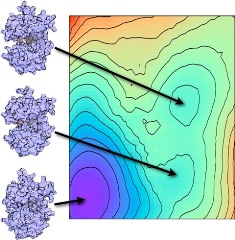
Albert Lau
WBSB 706
Research Interests
Our lab uses a combination of computational and experimental approaches to try to understand the atomic and molecular details governing the function of protein complexes involved in intercellular communication. The complexes that are studied include ionotropic glutamate receptors (iGluRs). iGluRs are ligand-gated ion channels that mediate the majority of excitatory synaptic transmission in the central nervous system. iGluRs are important in synaptic plasticity, which underlies learning and memory. Receptor dysfunction has been implicated in a number of neurological disorders. The binding of neurotransmitter molecules to the ligand-binding domains of iGluRs drives the opening of the associated transmembrane pore, allowing cations to flow intothe cell, which in turn triggers a nerve impulse. 
Computationally, we apply methods in molecular simulation and statistical thermodynamics to estimate the free energies and kinetics associated with ligand binding and protein conformational transitions. Our goal is to generate testable predictions that can help guide experimental investigations as well as help interpret experimental observations. Computational protein design is also explored. Experimentally, we pursue structural studies primarily using X-ray crystallography to help characterize macromolecular structure-function relationships. Biophysical insights can collectively be applied to the design of theapeutic agents.
Selected Publications
Evans DJ, Yovanno RA, Rahman S, Cao DW, Beckett MQ, Patel MH, Bandak AF, Lau AY. Finding druggable sites in proteins using TACTICS. J Chem Inf Model. 2021; 61(6):2897–2910. https://doi.org/10.1021/acs.jcim.1c00204.
Chin AC, Yovanno RA, Wied TJ, Gershman A, Lau AY. D-serine potently drives ligand-binding domain closure in the ionotropic glutamate receptor GluD2. Structure. 2020; 28(10):1168–1178. https://doi.org/10.1016/j.str.2020.07.005.
Wied T, Chin AC, Lau AY. High conformational variability in the GluK2 kainate receptor ligand-binding domain. Structure. 2019; 27(1):189–195. https://doi.org/10.1016/j.str.2018.09.008.
Yu A, Lau AY. Glutamate and glycine binding to the NMDA receptor. Structure. 2018; 26(7):1035–1043. https://doi.org/10.1016/j.str.2018.05.004.
Yu A, Salazar H, Plested AJR, Lau AY. Neurotransmitter funneling optimizes glutamate receptor kinetics. Neuron. 2018; 97(1):139–149. https://doi.org/10.1016/j.neuron.2017.11.024.
